NASA gave a progress update this week on how their safety improvements to the space shuttle are going. It turns out, a $.99 foam brush does the best job of applying a special patch material that the astronauts can use to repair the shuttle’s heat tiles. They’re also working on ways to get better photos of the shuttle as it launches – even at night; currently the shuttle’s exhaust is too bright at night to really see the vehicle well enough to spot problems. The space shuttle Atlantis will likely be the next to launch, some time in September 2004.
NASA Moves Forward with Supersonic Airplane
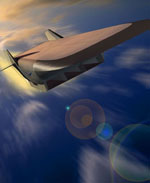
Image credit: NASA
NASA has picked Allied Aerospace to continue the development of its X-34C experimental aircraft. The $150 million contract will have Allied create three flight-ready demonstrator vehicles that will fly more than 8,000 kilometres per hour; or seven times the speed of sound. The vehicle is intended to demonstrate a working scramjet engine, which pulls part of its fuel from the air – making it smaller and more efficient. The demonstration aircraft will be launched atop a Pegasus rocked and raised to Mach 5; then they’ll disengage and speed up to Mach 7 under their own power.
NASA has selected Allied Aerospace Industries of Tullahoma, Tenn., to provide three flight-ready experimental demonstrator vehicles that will fly approximately 5,000 miles per hour or seven times the speed of sound. The multi-year project, called X-43C, will expand the hypersonic flight envelope for air-breathing engines.
The cost-plus-fixed-fee completion type contract carries performance incentives and is valued at nearly $150 million over 66 months. The base activity covers all work through completion of the Preliminary Design Review, and the optional effort covers the final design, hardware fabrication and all associated support activities.
The X-43C is the next logical step, following the Hyper-X (X-43A), vehicle that aims at demonstrating short duration scramjet powered flight at Mach 7 and Mach 10. The X-43C will demonstrate free flight of a scramjet-powered vehicle with acceleration capability from Mach 5 to Mach 7, as well as operation of a hydrocarbon fuel-cooled scramjet.
NASA’s Langley Research Center (LaRC), Hampton, Va. is leading a combined U.S. Air Force/industry team in the design and development of the X-43C demonstrator vehicle and its propulsion system. The engine, which will be provided by the Air Force, will be a dual-mode scramjet capable of running as a ramjet or scramjet.
Allied Aerospace, Flight Systems Division, will team with Pratt & Whitney, West Palm Beach, Fla.; Boeing Phantom Works, Huntington Beach, Calif.; and RJK Technologies, Blacksburg, Va.
Work will be performed primarily in Tullahoma and West Palm Beach. Some contract work will also take place at Huntington Beach, Blacksburg, St. Louis, LaRC and NASA’s Dryden Flight Research Center (DFRC), Edwards, Calif.
Future air-breathing space access vehicles offer advantages over conventional rocket-powered vehicles that must carry all of the oxidizer needed to burn their fuel. Air-breathing engine-powered vehicles obtain oxygen from the atmosphere in flight. By minimizing the need to carry oxidizer, smaller and more efficient vehicles can be designed for space access missions.
‘When fully developed, these advanced propulsion systems will offer increased safety, payload capacity and economy of operation for future, reusable space access vehicles,” said Paul Moses, manager of the X-43C project. “The X-43C project will validate advanced technologies, design tools and test techniques that will enable design of such vehicles in the future,” he said.
For the three demonstration flights, a Pegasus-derived rocket booster will be air-launched by a carrier aircraft to boost the X-43C demonstrator vehicles to Mach 5 at approximately 80,000 feet. The X-43C will separate from the booster and continue to accelerate to Mach 7 under its own power and autonomous control.
Flights will originate from DFRC. Flight paths of the vehicles will be over water within the Pacific Test Range.
Original Source: NASA News Release
Canada Joins Galileo System
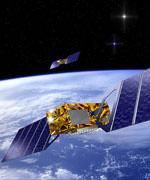
Image credit: ESA
The Canadian Space Agency announced today that it will be contributing to the development of Galileo, the space-based navigation system being created by the European Space Agency – similar to the US Global Positioning System. Canada will contribute $11 million which will open up the development stage of the project to accept bids from Canadian contractors. China announced a similar commitment last month. Galileo is expected to be fully operational by 2008.
Canada’s space industry will directly benefit from an Arrangement signed yesterday between the Canadian Space Agency (CSA) and the European Space Agency (ESA) that ensures Canada’s participation in the Development and Validation Phase of Europe’s Galileo Program.
Galileo is a European satellite navigation and positioning system that will provide highly accurate global positioning services. The CSA’s $11 million contribution to this phase of Galileo allows Canadian companies to respond to requests for proposals and to take an active part in the program.
“By collaborating with ESA in this leading-edge international satellite navigation initiative, Canada is targeting its funding to provide new and exciting opportunities for the Canadian space industry,” said Allan Rock, Minister of Industry and Minister responsible for the CSA.
Galileo is a joint initiative of the European Commission and ESA. It will be the first satellite positioning and navigation system intended specifically for civilian purposes and it will improve the reliability and availability of navigation and positioning services worldwide. When fully deployed in 2008, Galileo will employ up to 30 satellites in medium earth orbit, and will be supported by a worldwide network of ground stations. The Development and Validation Phase will take place from 2003 to 2006.
“Galileo’s new generation of navigation services will also benefit Canadians in such areas as air and sea traffic control, ground transportation, crime prevention, urban planning, agriculture and fisheries,” said Marc Garneau, President of the CSA.
The Arrangement was signed yesterday in Paris by Raymond Chr?tien, Canada’s Ambassador to France, on behalf of the Government of Canada, and by Jean-Jacques Dordain, ESA’s Director General.
About Canada and ESA
The European Space Agency (ESA) is composed of 15 Member States. Canada is a Cooperating Member and the only non-European country to participate directly in earth observation, telecommunications, navigation, exploration and technology development programs of ESA. Under the terms of the Canada-ESA Cooperation Agreement, CSA’s contributions to ESA programs are returned in the form of contracts to Canadian industry. The year 2004 will mark the 25th anniversary of Canada-ESA collaboration.
About the Canadian Space Agency
Established in 1989 with its Headquarters situated in Longueuil, Quebec, the CSA is responsible for the overall national program. The CSA delivers services relating to Earth and the Environment, Space Science, Human Presence in Space, Satellite Communications, Space Technology, Space Qualification Services, Space Awareness and Education. The CSA is at the forefront of the development and application of space knowledge for the benefit of Canadians and humanity.
Original Source: CSA News Release
Searching for Moons Around Distant Planets
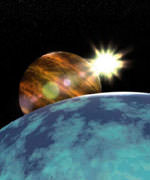
Image credit: ESA
The European Space Agency is working on a new mission that could be able to detect moons orbiting planets in other star systems. In 2008, the ESA will launch Eddington, which will detect the drop in light as planets as small as Mars pass in front of their parent stars. Astronomers should theoretically be able to detect moons going around those planets because of their gravity – if the planet dims the star a few minutes earlier or later than expected, it will have one or more moons.
ESA is now planning a mission that can detect moons around planets outside our Solar System, those orbiting other stars.
Everyone knows our Moon: lovers stare at it, wolves howl at it, and ESA recently sent SMART-1 to study it. But there are over a hundred other moons in our Solar System, each a world in its own right.
A moon is a natural body that travels around a planet. Moons are a by-product of planetary formation and can range in size from small asteroid-sized bodies of a few kilometres in diameter to several thousand kilometres, larger even than the planets Mercury and Pluto.
Landing on another moon
One such large moon is Titan, the target for ESA?s daring Huygens mission that in 2005 will become the first spacecraft ever to land on a moon of another planet. Titan is slightly bigger than the planet Mercury, and is only called a moon because it orbits the giant planet Saturn rather than the Sun.
Four other large moons can be found around another of our neighbours, Jupiter. These are Io, Europa, Ganymede and Callisto. Europa has captured attention because beneath its icy surface, scientists think that an ocean covers the entire moon. Some scientists have even speculated that microscopic life might be found in that ocean.
Habitable moons?
In 2008, ESA plans to launch its ?rocky planet? finder Eddington. By detecting the drop in light seen when a world passes in front of its parent star, Eddington will be capable of discovering planets the size of Jupiter, and also those smaller than Mars.
That means, if our own Solar System is anything to go by, it will be capable of detecting moons similar in size to Titan and the four large moons of Jupiter.
It would be particularly exciting if such combinations of planets and moons were found orbiting a star at Earth?s distance from the Sun. Perhaps then the surfaces of the moons would be warmed to habitable levels.
Orbital dancing
What about moons similar to our own? An equivalent of Earth?s moon would be too small to be detected directly by Eddington, but such a body would affect the way its planet moves and it is that movement which Eddington could detect.
The Earth and the Moon orbit the Sun like ballroom dancers who move around the floor, simultaneously twirling about one another. This means the Earth does not follow a strictly circular path through space, sometimes it will be leading the Moon and sometimes trailing.
This causes variations of up to five minutes from where the Earth would be if it did not possess a moon. By precisely timing when a rocky planet passes in front of its star, Eddington will be able to show if a moon is pulling its planet out of a strictly circular path around the star.
So, how many moons can Eddington expect to find circling planets around other stars? If we make an estimate based on our own Solar System, several thousands will be found ? however, no one knows for sure. That?s what makes the quest so exciting!
Original Source: ESA News Release
Keck Uses Adaptive Optics for the First Time
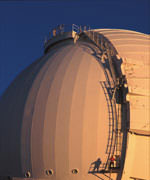
Image credit:: Keck
The 10-metre Keck II observatory took an important step forward recently when it began observations with its new adaptive optics system. The system uses a laser to create a fake star about 90 kilometres up in the sky – a computer can then use this to calculate how to remove the effect of atmospheric disturbances. Adaptive optics have been used on smaller telescopes, but this is the first time it’s been employed on a telescope as large as the mighty Keck II; it took nine years to adapt the observatory.
A major milestone in astronomical history took place recently at the W.M. Keck Observatory when scientists, for the first time, used a laser to create an artificial guide star on the Keck II 10-meter telescope to correct the blurring of a star with adaptive optics (AO). Laser guide stars have been used on smaller telescopes, but this is their first successful use on the current generation of the world’s largest telescopes. The resulting image (Figure 1), captured by the NIRC2 infrared camera, was the first demonstration of a laser guide star adaptive optics (LGS AO) system on a large telescope. When complete, the LGS AO system will mark a new era of astronomy in which astronomers will be able to see virtually any object in the sky with the clarity of adaptive optics.
“This is one of the most gratifying moments in all my years at Keck,” remarked Dr. Frederic Chaffee, director of the W.M. Keck Observatory the evening the observations were made. “Like any positive first light result, there is much to be done before the system can be considered operational. But also like any positive first light result, it shows that it can be done, and gives us great optimism that our goals are not impossible dreams, but are instead attainable realities.”
Adaptive optics is a technique that has revolutionized ground-based astronomy through its ability to remove the blurring of starlight caused by the earth?s atmosphere. Its requirement of a relatively bright “guide star” in the same field of view as the scientific object of study has generally limited the use of AO to about one percent of the objects in the sky.
To overcome this restriction, in 1994 the W.M. Keck Observatory began working with Lawrence Livermore National Labs (LLNL) to develop an artificial guide star system. By using a laser to create a ?virtual star,? astronomers can study any object in the vicinity of much fainter (up to 19th magnitude) objects with adaptive optics and reduce its dependence on bright, naturally occurring guide stars. Doing so will increase sky coverage for the Keck adaptive optics system from an estimated one percent of all objects in the sky, to more than 80 percent.
“This new capability of using a laser guide star with a large telescope has invited astronomers to start exploring the night sky in a much more comprehensive manner,” said Adam Contos, optics engineer at the W.M. Keck Observatory. “In the future, I would expect most major observatories to be installing similar systems to take advantage of this incredible enhancement to their AO capabilities.”
In January 2001, after more than seven years in development, the Keck and LLNL teams celebrated the completion of the Keck laser guide star system. The artificial star results when light from a 15-watt dye laser causes a naturally occurring layer of sodium atoms to glow about 90 km (56 miles) above the earth’s surface. It would take another two years of sophisticated research and design before the laser system could be integrated into the Keck II adaptive optics system.
In the early morning hours of September 20th, all subsystems finally came together to reveal the unique capability of the Keck LGS AO system and its potential to resolve extremely faint objects. The system locked on a 15th magnitude star, a member of a well-known T Tauri binary called HK Tau and revealed details of the circumstellar disk of the companion star. It was the first time an adaptive optics system on a very large telescope had ever used an artificial guide star to resolve a faint object.
A key challenge the LGS AO team faced was how successful the efforts would be to integrate and achieve good performance measurements for each required sub-system. Concerns about the power of the laser and its spot quality, operation of the laser traffic control system, the ability of the new sensors to lock on fainter guide stars, and being able to optimize the image quality through an accurate understanding of the aberrations that could not be measured by using the laser guide star, were all factored into the evening’s observing.
“First light was a superb team effort,” said Dr. Peter Wizinowich, team leader for the adaptive optics team at W.M. Keck Observatory. “It was very satisfying to have each of the many subsystems perform so well on our first attempt. To quote Virgil, ‘Audentes Fortuna Juvat,’ fortune favors the bold.”
The quality of the LGS AO first light images was extremely high. While locked on a 14th magnitude star, the Keck LGS AO system recorded “Strehl ratios” of 36 percent (at 2.1 micron wavelength, 30-second exposure time, Figure 3), compared to four percent for uncorrected images. Strehl ratios measure the degree to which an optical system approaches “diffraction-limited” perfection, or the theoretical performance limit, of the telescope.
Another performance metric, the “full width at half maximum” (FWHM), for this 14th magnitude star was 50 milli-arcseconds, compared to 183 milli-arcseconds for the uncorrected image. FWHM measurements help astronomers determine the actual edges of an object, where the detection may be imprecise or difficult to determine. The measurement of 50 milli-arcseconds is about equivalent to being able to distinguish a pair of car headlights in New York while standing in Los Angeles.
Throughout the evening, the laser guide star held steady and bright, shining at an approximate magnitude of 9.5, about 25 times fainter than what the human eye can see, but ideal for the Keck adaptive optics system to measure and correct for atmospheric distortions.
Additional work is underway before the Keck LGS AO system can be considered fully operational. The Keck LGS AO system will be available for limited shared risk science next year, with full deployment to the Keck user community in 2005.
“Even with just this first test, astronomers are already clamoring to use the laser guide star system to study distant galaxies with an unprecedented resolution and power,” said Dr. David Le Mignant, adaptive optics instrument scientist at the W.M. Keck Observatory, California Association for Research in Astronomy. “By next year, adaptive optics will be used to study the rich formation history of early galaxies.”
The importance of this breakthrough to worldwide astronomy was summed up by Dr. Matt Mountain, the director of the Gemini Observatory, which operates twin 8-meter telescopes, one on Mauna Kea and one on Cerro Pachon in Chile: “This is a critical milestone for all ground-based astronomy, not just for our current generation of eight to 10-meter class telescopes, but also for our dreams of 30-meter telescopes.”
Team members responsible for the Keck LGS AO system are Antonin Bouchez, Jason Chin, Adam Contos, Scott Hartman, Erik Johansson, Robert Lafon, David Le Mignant, Chris Neyman, Paul Stomski, Doug Summers, Marcos van Dam, and Peter Wizinowich, all from the W.M. Keck Observatory, California Association for Research in Astronomy. The team gave special thanks to their collaborators at LLNL: Dee Pennington, Curtis Brown and Pam Danforth.
The laser guide star adaptive optics system was funded by the W.M. Keck Foundation.
The W.M. Keck Observatory is operated by the California Association for Research in Astronomy, a scientific partnership of the California Institute of Technology.
Original Source: Keck News Release
More Chinese Launch Plans Emerging
News reports in China have stated that the Chinese are will attempt to join the nations capable of sending humans into space on October 15, a day after the meeting of Communist party members. The Shenzhou 5 spacecraft will carry a single astronaut (or yuhangyuan) into space for a single 90-minute loop around the Earth. It appears the Chinese are going to be very conservative on their first launch attempt, essentially matching the flight that Yuri Gagarin made more than 40 years ago. There hasn’t been an official launch announcement from the government yet.
Book Review: Hubble: The Mirror on the Universe
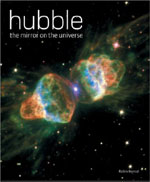
“Hubble: The Mirror on the Universe” by Robin Kerrod is the newest coffee table book filled with beautiful pictures from the Hubble Space Telescope. The 192-page hardcover contains hundreds of pictures, of objects as near as our solar system to the very edges of the Universe.
The book is categorized into different kinds of astronomical objects, so the chapters go like: Stars in the Firmament, Stellar Death and Destruction, etc. Each chapter is broken up into a collection of images from Hubble that relate to the topic, and then a nice description of what’s going on in the picture. Robin Kerrod is an accomplished astronomy writer (The Sky at Night, History of NASA, more) and it really helps to have a knowledgeable guide take you through the pictures. There are also plenty of full page, and even two-page spreads dedicated to some of the best pictures from Hubble.
The book was only published in September 2003, so its big advantage to all the other Hubble coffee table books is that it’s got the newest photos. I noticed some pictures that were only released a few months ago.
What surprised me when I read the book is that it’s really an overview of astronomy, using pictures from Hubble as a background to the descriptions. Instead of ignoring things that Hubble hasn’t taken pictures of, Kerrod included pictures from other sources other than Hubble – I think this was a wise move because it makes the book a more complete view of space and astronomy than a narrow view through the Hubble mirror.
The pictures are beautiful, no argument here – you’ll recognize many of them. And the text is comprehensive and well-written. There’s really good background information on the observatory itself; how it was built, launched, repaired and upgraded.
Although it was great to see additional text and pictures to make the book a more complete view of astronomy, the non-Hubble pictures aren’t clearly marked. Sometimes there’s a mention in the image caption, and there are image credits at the back of the book, but it would have been helpful if they stated it clearly beside the images. So, you can’t assume that every picture you’re looking at was actually taken by Hubble.
Here’s a link to more information from Amazon.com – Amazon.ca – Amazon.co.uk
Pengiuns Get a Boost from Plankton Blooms
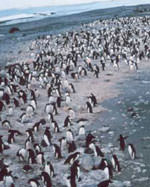
Image credit: NASA
NASA satellite data has been used to analyze the biology of open area “hotspots” around the coast of Antarctica. The research has found that penguin populations are healthy when there are patches of open water nearby where plankton blooms can form in the sunlight. The plankton feeds shrimp-like krill which supports many other marine animals including penguins. The data was gathered by NASA’s Sea-viewing Wide Field-of-view Sensor (SeaWiFS) and NOAA’s Advanced Very High Resolution Radiometer (AVHRR) which kept weekly records of ocean temperature and plankton levels.
NASA satellite data was used for the first time to analyze the biology of hot spots along the coast of Antarctica. The biological oases are open waters, called polynyas, where blooming plankton support the local food chain.
The research found a strong association between the well being of Adelie Penguin populations in the Antarctic and the productivity of plankton in the polynyas. Polynyas are areas of open water or reduced ice cover, where one might expect sea ice. They are usually created by strong winds that blow ice away from the coast leaving open areas, or by gaps appearing on the ocean’s surface, when flowing ice gets blocked by an impediment, like an ice shelf.
The Antarctic waters are rich in nutrients. The lack of ice, combined with shallow coastal waters, provides the top layers of the ocean with added sunlight, so polynyas offer ideal conditions for phytoplankton blooms. Because the ice around polynyas is thin in the early spring when the long Austral day begins, they are the first areas to get strong sunlight. The open waters retain more heat, further thinning ice cover and leading to early, intense, and short-lived plankton blooms. These blooms feed krill, a tiny, shrimp-like animal, which in turn are eaten by Adelie Penguins, seabirds, seals, whales, and other animals.
Although relatively small in area, coastal polynyas play a disproportionately important role in many physical and biological processes in Polar Regions. In eastern Antarctica, more than 90 percent of all Adelie Penguin colonies live next to coastal polynyas. Polynya productivity explains, to a great extent, the increase and decrease in penguin population.
“It’s the first time anyone has ever looked comprehensively at the biology of the polynyas,” said Kevin Arrigo, assistant professor of Geophysics at Stanford University, Stanford, Calif. “No one had any idea how tightly coupled the penguin populations would be to the productivity of these polynyas. Any changes in production within these polynyas are likely to lead to dramatic changes in the populations of penguins and other large organisms,” Arrigo said.
The study, which appeared in a recent issue of the Journal of Geophysical Research, used satellite-based estimates to look at interannual changes in polynya locations and sizes; abundance of microscopic free-floating marine plants called phytoplankton, which are the base of the polar ocean food chain; and the rate at which phytoplankton populations thrive. Covering five annual cycles from 1997 to 2002, 37 coastal polynya systems were studied.
The largest polynya studied was located in the Ross Sea (396,500 square kilometers or 153,100 square miles; almost the size of California). The smallest was located in the West Lazarev Sea (1,040 square kilometers or 401.5 square miles). Most polynyas, at their maximum area in February, were less than 20,000 square kilometers (7,722 square miles).
Data from NASA’s Sea-viewing Wide Field-of-view Sensor (SeaWiFS) and NOAA’s Advanced Very High Resolution Radiometer (AVHRR) provided weekly measurements of chlorophyll and temperature that were used in a computer model to estimate phytoplankton productivity. The researchers found, taken together, the Ross Sea, Ronne Ice Shelf, Prydz Bay, and Amundsen Sea polynyas were responsible for more than 75 percent of total plankton production.
The researchers were surprised to find how closely connected the Adelie Penguins were to the productivity of their local polynyas. The more productive polynyas supported larger penguin populations. The more abundant krill fed more penguins, and the birds had shorter distances to go to forage, which reduced exposure to predators and other dangers.
The NASA Oceanography Program, the National Science Foundation, and the U.S. Department of Energy funded this research. NASA’s Earth Science Enterprise is dedicated to understanding the Earth as an integrated system and applying Earth System Science to improve prediction of climate, weather, and natural hazards using the unique vantage point of space.
Original Source: NASA News Release
Chinese Could Launch Very Soon
The Chinese might be days away from launching their first humans into space, according to various experts and insiders. Normally quiet about future launch plans, the Chinese government is starting to make more comments about what could happen soon – the launch could happen as early as this weekend, but others believe the launch won’t happen before October 15 as government officials are in a series of meetings and would like to be present for the launch. All of the astronauts (or yuhangyuan) are at the launch facility and the Shenzhou 5 spacecraft has been mated to the top of its Long March rocket.
Virgo Cluster Sucks in Distant Galaxy
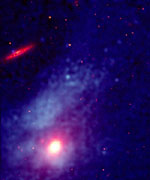
Image credit: Chandra
A new image taken by the Chandra X-Ray Observatory shows the elliptical galaxy M86 and its 200,000 light-year long tail. This gigantic galaxy is located in the Virgo galaxy cluster and moving 4.8 million kilometres per hour through clouds of gas in the cluster. The Virgo cluster is hurtling away from us, but M86 is on the opposite side and being pulled into it, so the net effect is that M86 is actually one of the few galaxies actually moving towards our own Milky Way.
This composite X-ray (blue)/optical (orange) image of M86 shows gas being swept out of the galaxy to form a long tail more than 200,000 light years in length. Located in the Virgo galaxy cluster, this enormous elliptical galaxy is moving at about 3 million miles per hour through diffuse hot gas that pervades the cluster. The supersonic motion of M86 produces pressure that is stripping gas from the galaxy and forming the spectacular tail.
M86 has been pulled into the Virgo galaxy cluster and accelerated to a high speed by the enormous combined gravity of dark matter, hot gas, and hundreds of galaxies that comprise the cluster. The infall of the galaxy into the cluster is an example of the process by which galaxy groups and galaxy clusters form over the course of billions of years.
The galaxy is no longer an “island universe” with an independent existence. It has been captured and its gas is being swept away to mix with the gas of the cluster, leaving an essentially gas-free galaxy orbiting the center of the cluster along with hundreds of other galaxies.
M86 is an unusual galaxy in that it is one of a small number of galaxies that are moving toward Earth, rather than receding with the general expansion of the Universe. This expansion is carrying the Virgo cluster away from us at a speed of about 2 million miles per hour, but M86 is falling into the Virgo cluster from the far side of the cluster, giving it a net velocity of about one million miles per hour toward Earth.
Original Source: Chandra News Release
